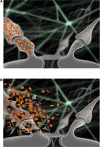Synapses, synaptic activity and intraneuronal abeta in Alzheimer's disease
- PMID: 20725518
- PMCID: PMC2912028
- DOI: 10.3389/fnagi.2010.00013
Synapses, synaptic activity and intraneuronal abeta in Alzheimer's disease
Abstract
beta-Amyloid peptide accumulation plays a central role in the pathogenesis of Alzheimer's disease. Aberrant beta-amyloid buildup in the brain has been shown to be present both in the extracellular space and within neurons. Synapses are important targets of beta-amyloid, and alterations in synapses better correlate with cognitive impairment than amyloid plaques or neurofibrillary tangles. The link between beta-amyloid and synapses became even tighter when it was discovered that beta-amyloid accumulates within synapses and that synaptic activity modulates beta-amyloid secretion. Currently, a central question in Alzheimer's disease research is what role synaptic activity plays in the disease process, and how specifically beta-amyloid is involved in the synaptic dysfunction that characterizes the disease.
Keywords: Alzheimer disease; amyloid; amyloid precursor protein; neprilysin; neurodegeneration; neuron; synapse; synaptic plasticity.
Figures

Similar articles
-
Synaptic activity reduces intraneuronal Abeta, promotes APP transport to synapses, and protects against Abeta-related synaptic alterations.J Neurosci. 2009 Aug 5;29(31):9704-13. doi: 10.1523/JNEUROSCI.2292-09.2009. J Neurosci. 2009. PMID: 19657023 Free PMC article.
-
Plaque formation and the intraneuronal accumulation of β-amyloid in Alzheimer's disease.Pathol Int. 2017 Apr;67(4):185-193. doi: 10.1111/pin.12520. Epub 2017 Mar 5. Pathol Int. 2017. PMID: 28261941 Review.
-
Intraneuronal Aβ accumulation, amyloid plaques, and synapse pathology in Alzheimer's disease.Neurodegener Dis. 2012;10(1-4):56-9. doi: 10.1159/000334762. Epub 2012 Jan 21. Neurodegener Dis. 2012. PMID: 22269167
-
Heterogeneous Association of Alzheimer's Disease-Linked Amyloid-β and Amyloid-β Protein Precursor with Synapses.J Alzheimers Dis. 2017;60(2):511-524. doi: 10.3233/JAD-170262. J Alzheimers Dis. 2017. PMID: 28869466 Free PMC article.
-
Beta-amyloid, neuronal death and Alzheimer's disease.Curr Mol Med. 2001 Dec;1(6):733-7. doi: 10.2174/1566524013363177. Curr Mol Med. 2001. PMID: 11899259 Review.
Cited by
-
Intracellular distribution of amyloid beta peptide and its relationship to the lysosomal system.Transl Neurodegener. 2012 Sep 26;1(1):19. doi: 10.1186/2047-9158-1-19. Transl Neurodegener. 2012. PMID: 23210724 Free PMC article.
-
Alzheimer's Disease Pathology and Assistive Nanotheranostic Approaches for Its Therapeutic Interventions.Int J Mol Sci. 2024 Sep 7;25(17):9690. doi: 10.3390/ijms25179690. Int J Mol Sci. 2024. PMID: 39273645 Free PMC article. Review.
-
MicroRNA-455-3P as a peripheral biomarker and therapeutic target for mild cognitive impairment and Alzheimer's disease.Ageing Res Rev. 2024 Sep;100:102459. doi: 10.1016/j.arr.2024.102459. Epub 2024 Aug 15. Ageing Res Rev. 2024. PMID: 39153602 Review.
-
GABA-A receptor modulating steroids in acute and chronic stress; relevance for cognition and dementia?Neurobiol Stress. 2019 Dec 20;12:100206. doi: 10.1016/j.ynstr.2019.100206. eCollection 2020 May. Neurobiol Stress. 2019. PMID: 31921942 Free PMC article.
-
RNA silencing of genes involved in Alzheimer's disease enhances mitochondrial function and synaptic activity.Biochim Biophys Acta. 2013 Dec;1832(12):2368-78. doi: 10.1016/j.bbadis.2013.09.008. Epub 2013 Sep 21. Biochim Biophys Acta. 2013. PMID: 24063855 Free PMC article.
References
-
- Apelt J., Ach K., Schliebs R. (2003). Aging-related down-regulation of neprilysin, a putative beta-amyloid-degrading enzyme, in transgenic Tg2576 Alzheimer-like mouse brain is accompanied by an astroglial upregulation in the vicinity of beta-amyloid plaques. Neurosci. Lett. 339, 183–18610.1016/S0304-3940(03)00030-2 - DOI - PubMed
Grants and funding
LinkOut - more resources
Full Text Sources
Other Literature Sources

